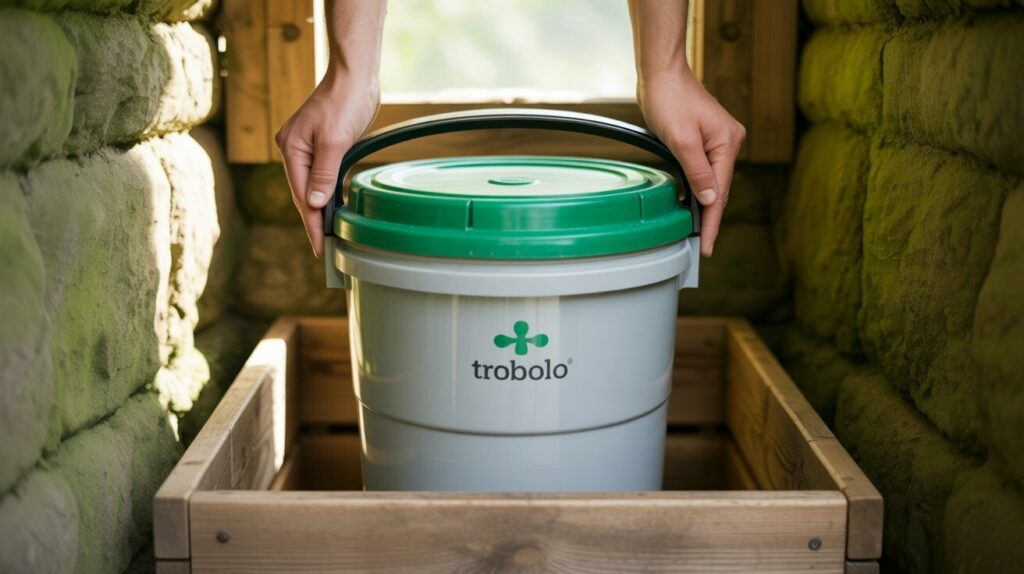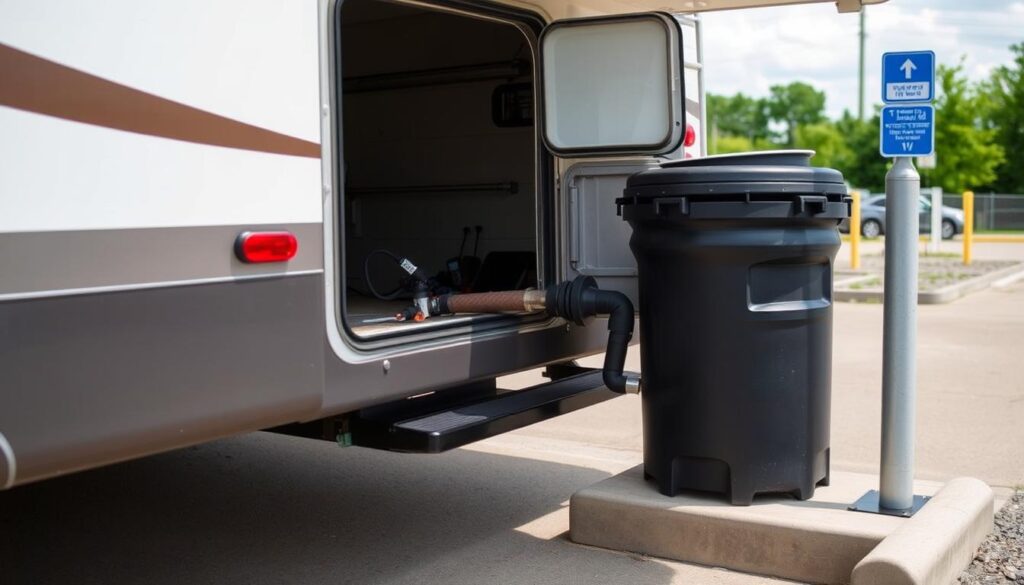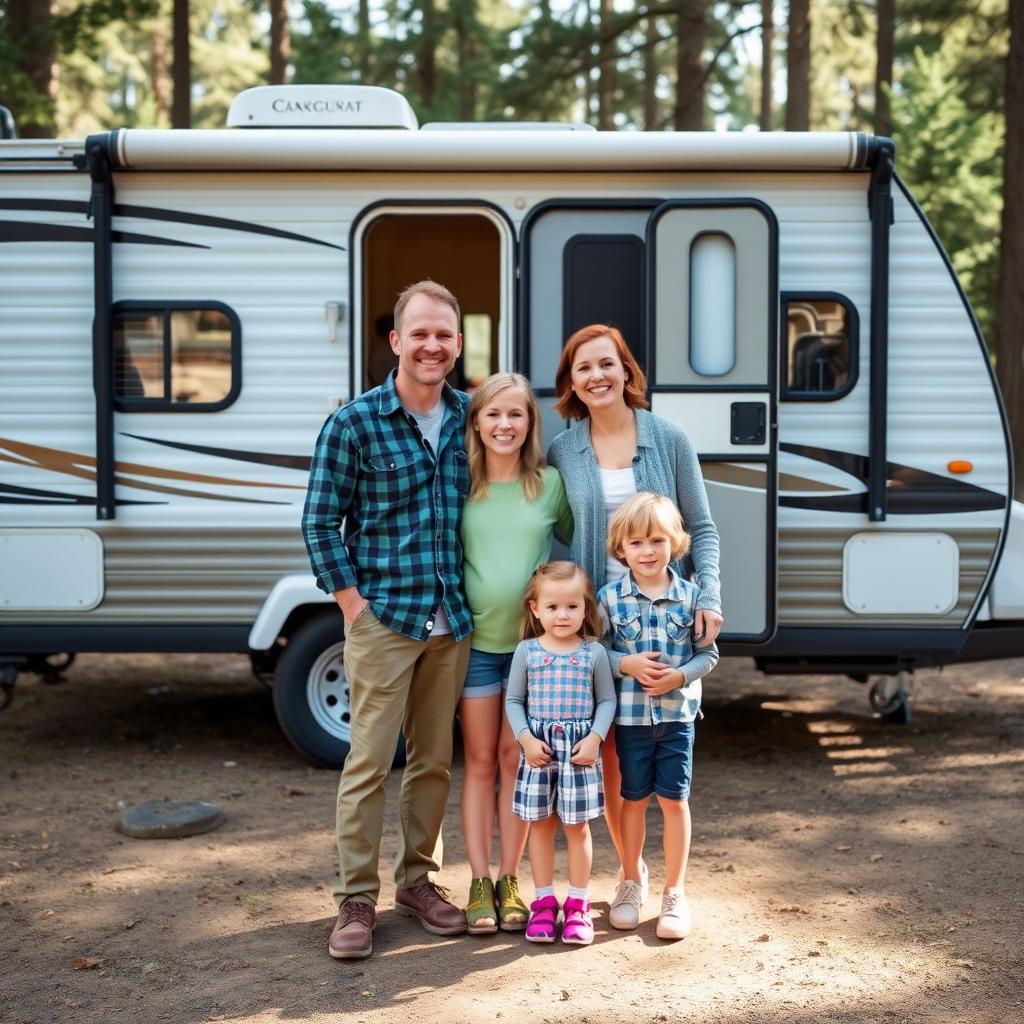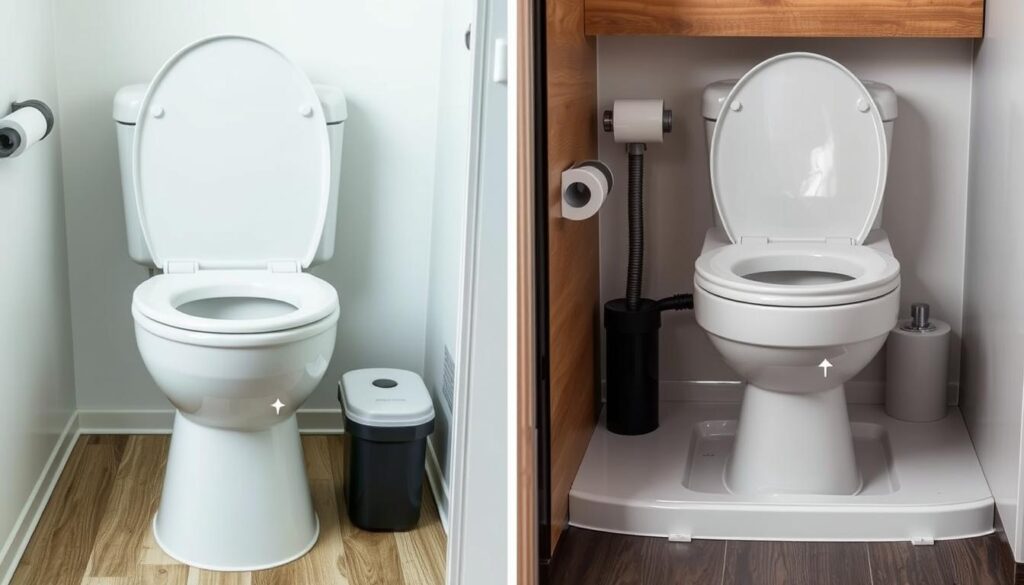The RV lifestyle is all about freedom and adventure, but one aspect that can limit your off-grid capabilities is bathroom management. As more travelers seek sustainable solutions, the debate between composting toilets and traditional RV holding tanks has intensified. This comprehensive comparison will help you understand the real differences in cost, maintenance requirements, odor control, and environmental impact – giving you the information you need to choose the right system for your travel style.
Understanding Both Systems: What Are They?
Traditional RV Holding Tanks
Traditional RV toilet systems function similarly to home toilets but instead of connecting to a sewer system, waste is stored in a black water tank beneath the RV. These systems use water to flush waste into the tank, where it remains until emptied at a designated dump station.
The black water tank typically holds between 15-50 gallons depending on your RV size. Chemical additives are used to break down solids and control odors until the tank can be emptied, usually every 3-7 days with regular use.
Composting Toilets
Composting toilets are waterless systems that separate liquid and solid waste. This separation is key to preventing odors and beginning the composting process. The solids chamber contains a medium like coconut coir or peat moss that helps break down waste and control moisture.
Most composting toilets use a small fan to maintain airflow, which keeps the composting medium dry and vents any potential odors outside the RV. The liquid waste is collected in a separate container that requires more frequent emptying than the solids chamber.
Cost Analysis: Upfront Investment vs. Long-Term Expenses
When comparing costs between these systems, it’s important to consider both the initial investment and ongoing expenses. While traditional systems often have lower upfront costs, composting toilets may offer savings over time.
| Cost Factor | Traditional RV Holding Tank | Composting Toilet |
| Equipment Cost | $150-$600 | $900-$1,400 |
| Installation | Often pre-installed or $200-$500 | $100-$300 (DIY possible) |
| Tank Chemicals | $10-$20/month | $0 |
| Composting Medium | $0 | $5-$15/month |
| Water Usage | 1-3 gallons per flush | None |
| Dump Fees | $5-$25 per dump | Minimal to none |
| 5-Year Total Cost Estimate | $1,500-$3,000 | $1,200-$2,000 |
Popular Models Comparison
Looking for a reliable composting toilet? The Nature’s Head Composting Toilet is the most popular choice among full-time RVers, offering durability and excellent odor control.
Traditional System Costs
While traditional RV toilets have a lower initial cost, the ongoing expenses add up. You’ll need to purchase tank chemicals regularly, pay for water to flush, and budget for dump station fees. Some RV parks include dumping in their overnight fees, but dedicated dump stations typically charge $5-$25 per use.
Popular traditional toilet models like the Thetford Aqua-Magic V ($150-$250) offer affordable replacement options, but don’t forget to factor in potential black tank sensor repairs and maintenance costs.
Composting Toilet Costs
The higher upfront cost of composting toilets ($900-$1,400 for popular models like Nature’s Head or Air Head) is offset by minimal ongoing expenses. You’ll need composting medium like coconut coir ($5-$15 per month), but you’ll save on water, chemicals, and dump fees.
For budget-conscious RVers, DIY composting toilet systems can be built for $200-$400 using a separating toilet seat, 5-gallon buckets, and a small computer fan for ventilation.
Maintenance Requirements: Day-to-Day Tasks and Long-Term Care

Traditional RV Toilet Maintenance
- Familiar flushing mechanism similar to home toilets
- Only requires emptying every 3-7 days depending on usage
- One-step emptying process at dump stations
- No need to handle separate waste containers
Traditional RV Toilet Challenges
- Requires finding dump stations (limited in some areas)
- Tank sensors often become inaccurate due to debris buildup
- Regular deep cleaning needed to prevent odors
- Potential for clogs and difficult repairs
- Risk of leaks and valve failures
Composting Toilet Maintenance
- No water or plumbing required
- Can be installed anywhere in the RV
- Liquid container can be emptied in regular toilets
- Solids only need emptying every 3-4 weeks for two people
- No chemical additives needed
Composting Toilet Challenges
- Liquid container needs emptying every 1-3 days
- Requires adding composting medium initially
- Solids need stirring/mixing after each use
- Learning curve for proper moisture balance
- Requires separate toilet paper disposal system
Daily Maintenance Comparison
Traditional System Daily Tasks
- Normal flushing after use (uses 1-3 gallons per flush)
- Monitor tank level sensors
- Add tank treatment chemicals as needed
- Plan travel routes around dump station availability
Composting Toilet Daily Tasks
- Turn the agitator handle after solid waste deposits
- Check liquid container level daily
- Empty liquid container every 1-3 days
- Dispose of toilet paper in separate container
- Ensure ventilation fan is operating properly
“After six months of full-time RVing, switching to a composting toilet was the best decision we made. Yes, emptying the liquid container is more frequent, but it’s so much easier than finding dump stations every few days. The solids container only needs emptying once a month, and there’s absolutely no smell when maintained properly.”
Odor Control: The Most Common Concern
Odor management is perhaps the most significant concern for RV owners considering toilet options. Both systems can be odor-free when properly maintained, but they use fundamentally different approaches.

Traditional System Odor Control
Traditional RV toilets rely on water and chemicals to control odors. The water creates a seal in the toilet bowl, while chemical additives in the tank break down waste and suppress smells. However, several factors can compromise this system:
- Valve leaks allowing tank odors to escape
- Inadequate chemical treatment
- Buildup on tank walls and sensors
- Hot weather accelerating decomposition
Most RVers report that traditional systems remain odor-free when properly maintained, but problems can develop over time, especially with sensor accuracy and valve seals.
Composting Toilet Odor Control
Composting toilets control odors through three primary mechanisms:
- Separation of liquid and solid waste (prevents the ammonia smell that occurs when they mix)
- Dry composting medium that absorbs moisture from solid waste
- Continuous ventilation through a small fan that draws air out of the RV
When properly maintained, composting toilets produce virtually no odor inside the RV. The ventilation system creates negative pressure that prevents smells from entering the living space.
“We were extremely skeptical about odors with a composting toilet. After two years of use, I can honestly say our Nature’s Head has LESS odor than our previous black tank system. The key is keeping liquids and solids separate and ensuring the vent fan runs continuously.”
Effective Odor Control Solutions
For traditional systems, RV owners consistently rate Camco TST Max as the most effective holding tank treatment for odor control and waste breakdown.
Environmental Impact: Water Usage, Chemicals, and Waste Management

As outdoor enthusiasts, many RVers are increasingly concerned about their environmental footprint. The toilet system you choose can significantly impact your resource consumption and waste management practices.
| Environmental Factor | Traditional RV Holding Tank | Composting Toilet |
| Water Usage | 1-3 gallons per flush (40-120 gallons weekly) | Zero (waterless system) |
| Chemical Usage | Regular chemical additives required | None required |
| Waste Processing | Sewage treatment facilities | Natural decomposition (solids), dilution (liquids) |
| Off-Grid Capability | Limited by tank capacity and dump station access | Extended off-grid capability |
| Energy Requirements | Water pump for flushing | Small fan (0.1-1.5 amps) |
Water Conservation
Traditional RV toilets use 1-3 gallons of fresh water per flush. For a couple using the toilet 5-6 times daily, this amounts to 35-126 gallons weekly – a significant amount of potable water, especially when boondocking with limited water supplies.
Composting toilets use no water for operation, making them ideal for water conservation and extended dry camping. This water savings alone can extend your boondocking capability by several days.
Chemical Usage and Waste Processing
Traditional System Impact
Most RV holding tank treatments contain biocides, formaldehyde, or other chemicals that can be harmful to septic systems and the environment. While “green” alternatives exist, they’re often less effective at odor control.
Black water from RVs must be disposed of at designated dump stations that connect to municipal sewage systems or dedicated treatment facilities. Improper disposal can contaminate groundwater and spread pathogens.
Composting Toilet Impact
Composting toilets require no chemicals for operation. The solid waste begins breaking down naturally in the composting chamber, though it doesn’t fully compost during typical use periods.
Liquid waste can be diluted and dispersed on appropriate ground (following Leave No Trace principles and local regulations) or emptied into regular toilets. Solid waste can be bagged and disposed of in trash receptacles where permitted, or in composting facilities.
Environmental Certification: Some composting toilet models like the Sun-Mar Excel and Nature’s Head meet NSF/ANSI Standard 41 for composting toilets, certifying their environmental performance and safety.
Real User Experiences: What RVers Actually Say
Beyond specifications and theoretical comparisons, real-world experiences provide valuable insights into how these systems perform in daily use. We’ve gathered feedback from different types of RVers to help you understand the practical realities.

Full-Time RVers: The Johnsons
After 3 years with a traditional black tank system, the Johnsons switched to a Nature’s Head composting toilet in their Class A motorhome.
Key Benefits:
- Extended boondocking capability (from 5 days to 2+ weeks)
- Eliminated black tank cleaning and sensor issues
- Reduced water consumption by 40%
Challenges:
- Initial adjustment to different usage habits
- More frequent emptying of urine container
- Occasional fan battery replacement

Weekend Campers: The Martinez Family
The Martinez family uses their travel trailer primarily for weekend trips and maintains a traditional black tank system.
Key Benefits:
- Familiar operation for all family members
- Sufficient capacity for weekend trips
- Lower initial investment
Challenges:
- Campground dump stations often have lines
- Occasional odor issues in hot weather
- Tank sensors becoming unreliable over time

Van Lifers: Alex & Jamie
Living full-time in a converted Sprinter van, Alex and Jamie use a hybrid approach with a composting toilet and portable cassette for flexibility.
Key Benefits:
- Maximum flexibility for urban and wilderness camping
- Space-efficient solution for small van
- No permanent plumbing required
Challenges:
- Managing multiple systems
- Limited capacity of cassette toilet
- Finding appropriate disposal locations in urban areas
“The biggest surprise was how much our composting toilet extended our boondocking time. We went from 4-5 days maximum to easily 2+ weeks without needing facilities. The water savings alone made the switch worthwhile, not to mention never having to hook up to a dump station again.”
Which System Is Right For You? Ideal Use Cases
Choosing between composting toilets and traditional RV holding tanks depends on your specific travel style, preferences, and priorities. Here’s a guide to help you determine which system might work best for your situation.
A Composting Toilet Might Be Right For You If:
- You frequently boondock or dry camp without hookups
- Water conservation is a priority for you
- You want to avoid dump stations entirely
- You’re comfortable with a different toilet experience
- You travel in areas with limited dump facilities
- You’re willing to make a larger upfront investment
- You don’t mind emptying the liquid container every 1-3 days
- Environmental impact is important to you
- You want to maximize your off-grid capabilities
- You have space for a separate toilet paper disposal system
A Traditional RV Holding Tank Might Be Right For You If:
- You primarily stay at campgrounds with dump facilities
- You prefer a familiar toilet experience
- You want a lower initial investment
- You’re comfortable with the dump station process
- You have limited technical knowledge about RV systems
- You prefer less frequent waste management (every 3-7 days)
- Water conservation is less critical for your travel style
- You don’t want to handle separate waste containers
- You travel with multiple people unfamiliar with composting toilets
- You want the simplest possible system to maintain
Ready to Make the Switch?
If you’re considering a composting toilet for your RV, the Nature’s Head Self-Contained Composting Toilet is the most popular choice among full-time RVers, offering excellent reliability and customer support.
Conclusion: Making Your Decision
Both composting toilets and traditional RV holding tanks have their place in the RV lifestyle. Your choice ultimately depends on your specific travel patterns, comfort with different waste management approaches, and environmental priorities.
Traditional systems offer familiarity and lower upfront costs but require regular access to dump stations and use more water and chemicals. Composting toilets provide greater independence, water conservation, and environmental benefits but require more frequent attention to the liquid container and a higher initial investment.
Many experienced RVers find that composting toilets offer significant advantages for boondocking and extended travel, while weekend campers who primarily use established campgrounds may find traditional systems perfectly adequate for their needs.
Whichever system you choose, proper maintenance is the key to odor-free, trouble-free operation. Both options can provide years of reliable service when used according to manufacturers’ recommendations.
Do composting toilets work in cold weather?
Yes, composting toilets can work in cold weather, though the composting process slows significantly in temperatures below 55°F (13°C). The toilet will still function for waste collection, but decomposition will be minimal until temperatures rise. Some RVers add a small heater near the composting chamber in winter to maintain decomposition.
How often do you need to empty a composting toilet?
For two people using a composting toilet full-time, the liquid container typically needs emptying every 1-3 days, while the solids container usually requires emptying every 3-4 weeks. Usage patterns and diet can affect these timeframes. Solo travelers might go 5-7 days between liquid container emptyings and 4-6 weeks for solids.
Can I install a composting toilet in any RV?
Yes, composting toilets can be installed in virtually any RV, regardless of whether it previously had a traditional toilet. The main requirements are space for the unit (they’re often taller than traditional RV toilets) and a way to vent the fan outside (typically through a 1-2 inch hole in the floor or wall). No connection to a black tank is needed, and the former black tank can be repurposed for additional gray water capacity.
What’s the best tank treatment for traditional RV holding tanks?
RVers report the best results with enzyme-based treatments like RV Digest-It and Happy Campers Organic RV Holding Tank Treatment. These break down waste effectively while being environmentally friendly. Traditional chemical treatments with formaldehyde work quickly but can damage septic systems and harm the environment. Many campgrounds now prohibit formaldehyde-based treatments.

